Other common names:
- Giant foxtail: Faber’s foxtail, Chinese millet
- Green foxtail: bottle grass, pigeon grass, wild millet, green brittle grass, pussy grass, green bristlegrass, green bottle grass
- Yellow foxtail: pigeon grass, summer grass, golden foxtail, wild millet, glaucous bristly foxtail, yellow bristle grass
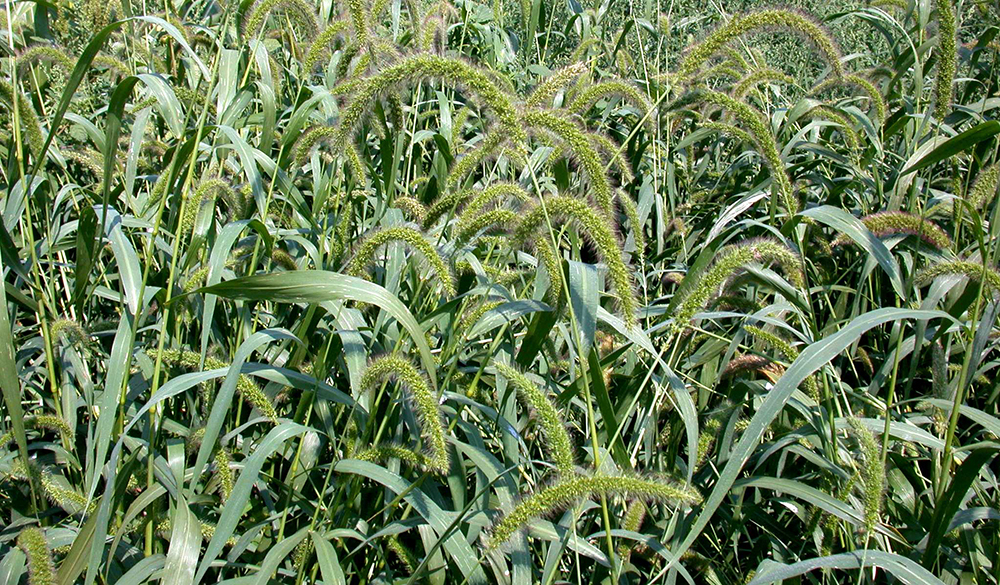
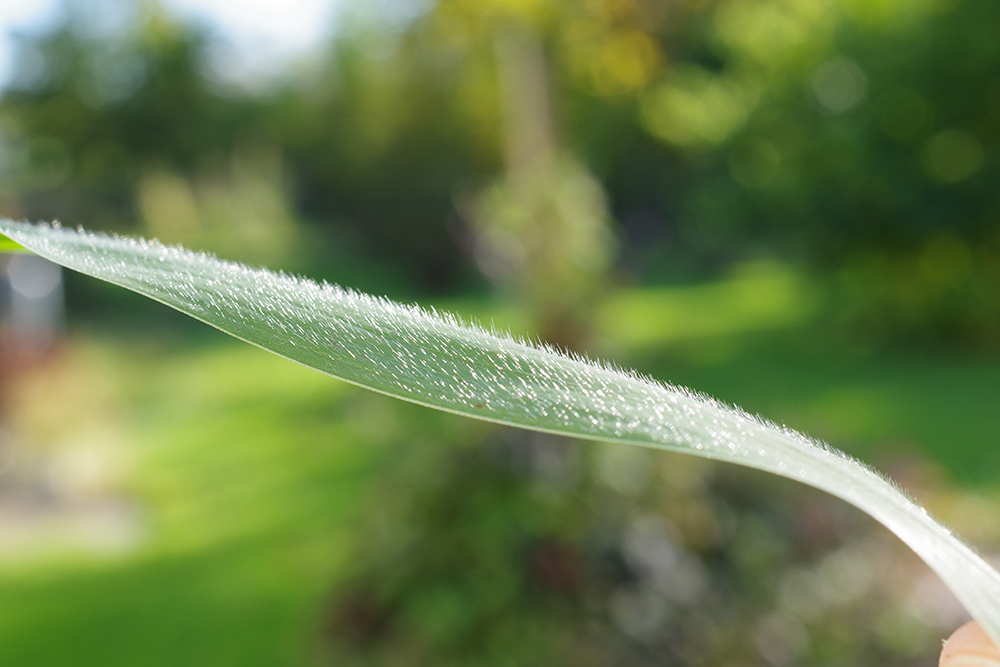
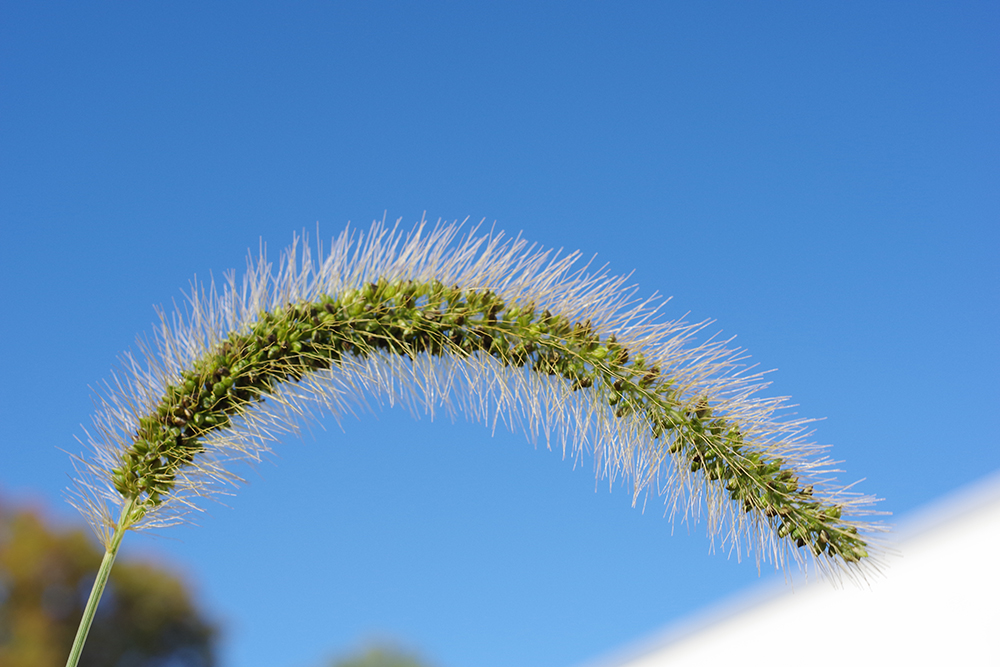
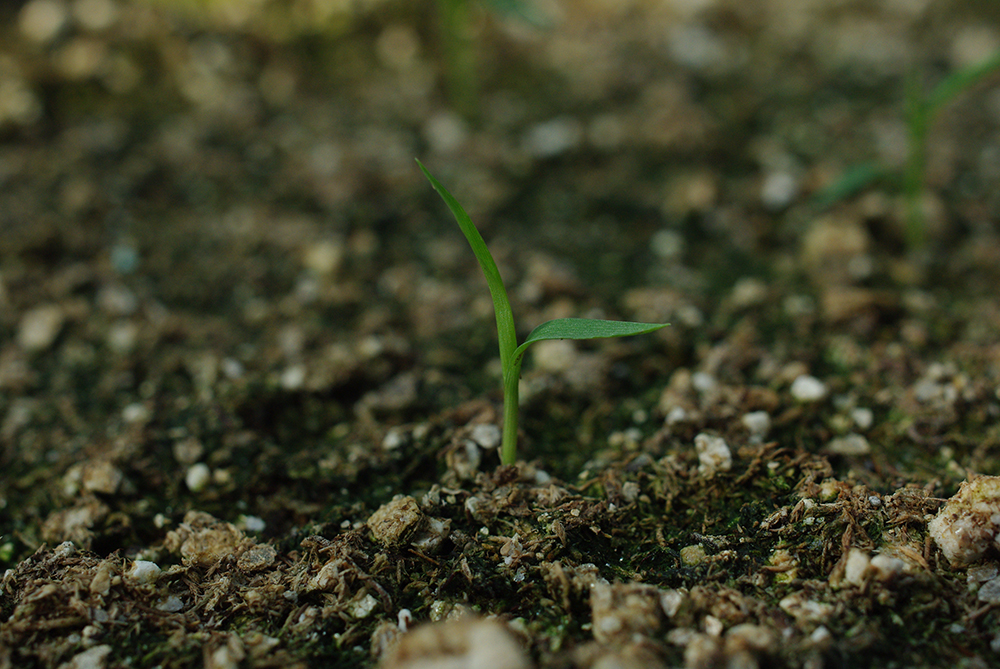
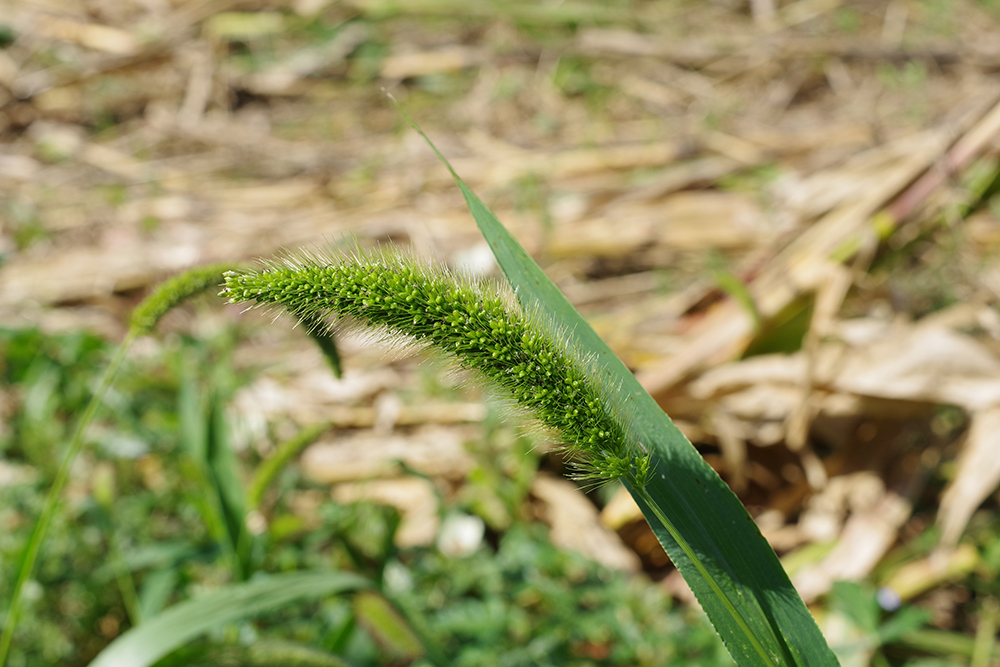
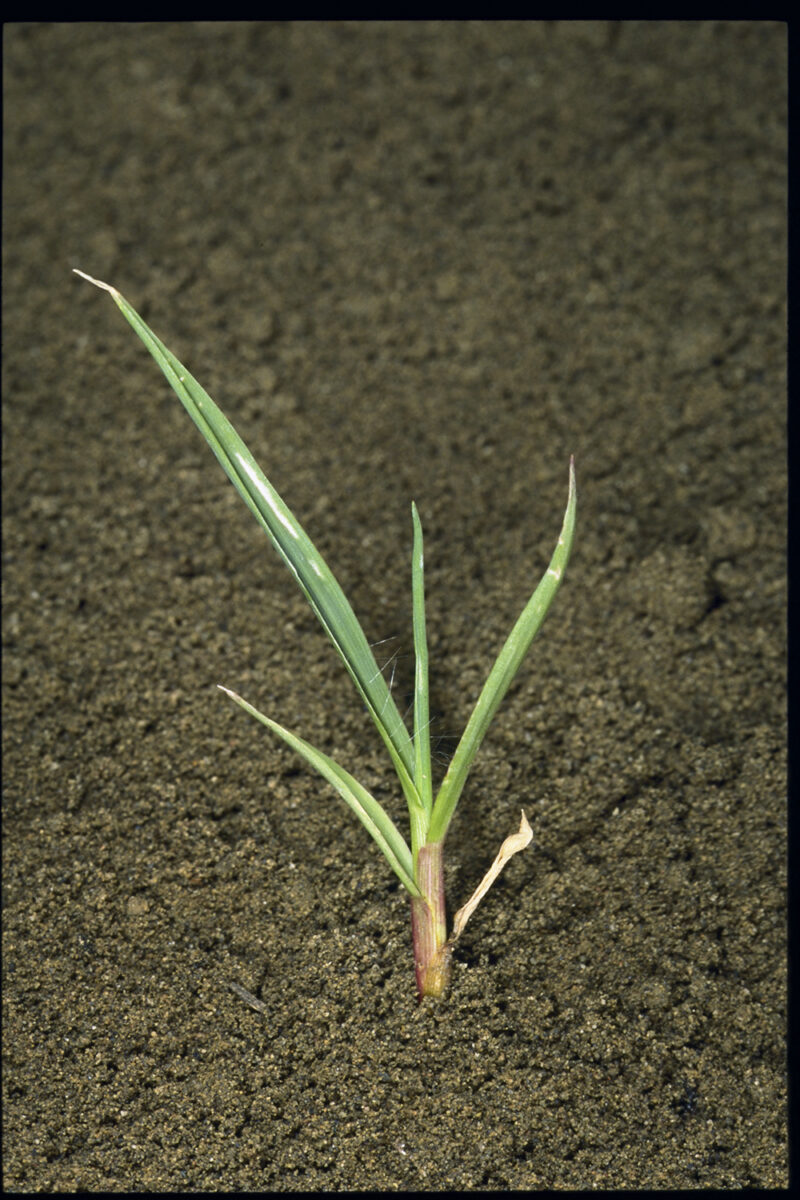
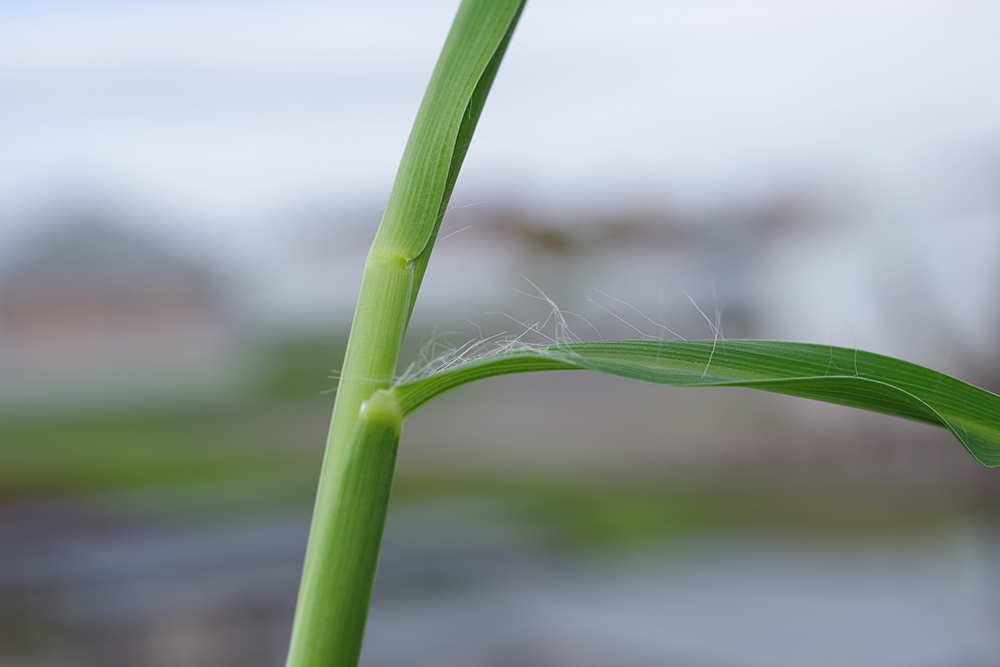
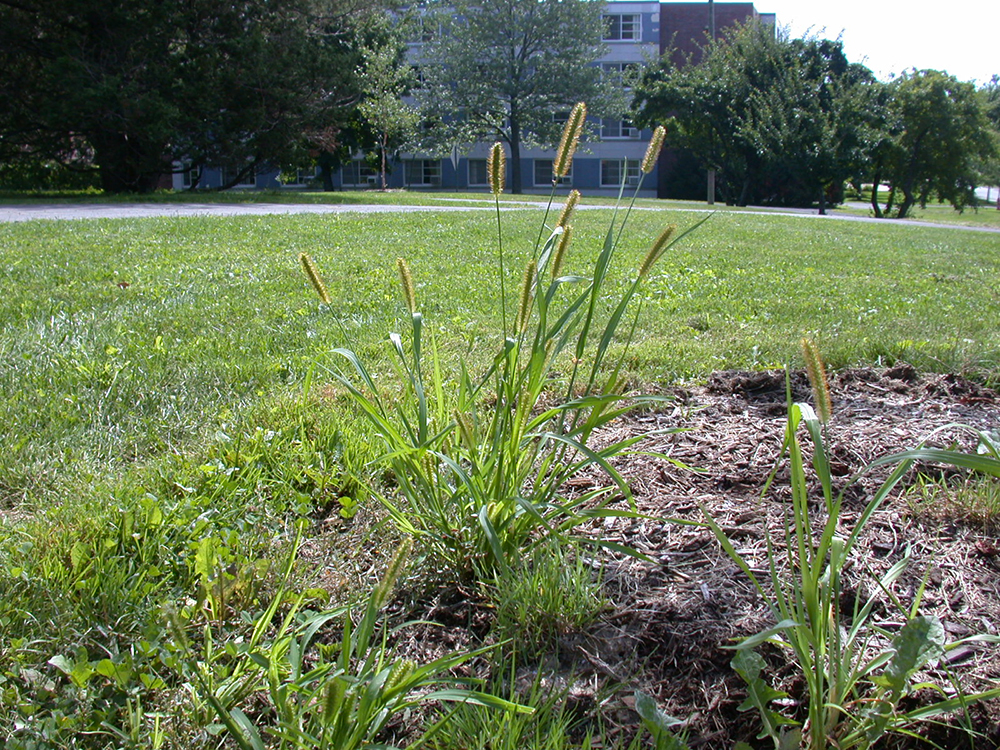
Identification of Foxtails
Giant foxtail, Setaria faberi Herrm.
Green foxtail, Setaria viridis (L.) P. Beauv.
Yellow foxtail, Setaria pumila (Poir.) Roem. & Schult. = S. glauca (L.) P. Beauv.
= S. lutescens (Weigel) F.T. Hubbard
Family: Grass family, Poaceae
Habit: Erect or sprawling summer annual grasses
Description:
Seedlings are rolled in the bud, uncurling roughly parallel to the ground. Ligules of all three species are very short and hairy. Auricles are absent.
- Giant foxtail: The seed leaf is oval, 0.5–1 inch long by 0.1–0.2 inch wide. Young true leaves have short hairs on the sheath margin and upper blade surface.
- Green foxtail: The seed leaf is 0.5–0.8 inch long by 0.1–0.16 inch wide. Young true leaf blades are hairless, rough and narrow, and light green with red near the collar; sheaths are densely hairy, slightly compressed and open at the top.
- Yellow foxtail: The seed leaf is elongated, up to 2 inches long by 0.13 inch wide. Leaf blade edges are smooth to slightly rough, and the rest of the blade is hairless and flat. The collar region is green and smooth with a scattering of long, silky hairs. The sheaths are hairless, ridged and compressed. The lower seedling stem may be red.
Mature plants have hairy, 0.04–0.13 inch-long ligules. The root system of these tillering plants is fibrous.
- Giant foxtail: Stems can reach up to 6.5 feet but are usually 2.5–4 feet tall. Stems are upright and hairless. Sheaths are light green and open, with a hairy edge. Ligules are densely hairy. Blades are arching, 12–20 inches long by 0.0.3–0.8 inches wide and light green with a white midrib; blades have short rough hairs covering their upper surface.
- Green foxtail: Thin, round stems are 0.5–3 feet tall and radiate vertically from the center of the plant. Sheaths are concentrated at the stem base, slightly flat, smooth to rough, self-wrapping and hairy edged. The collar may be reddish. Light green blades are flat, hairless and 10–12 inches long by 0.25–0.38 inch wide.
- Yellow foxtail: Stems can reach 2–4 feet in height. Sheaths are flattened, hairless, split open at the top, red at the base and collar, and have a ridged midvein. Ridged blades are 10–12 inches long by 0.25–0.5 inch wide, with 0.13–0.4 inch long, silky hairs on the upper surface near the collar. Plants are sometimes red at the base.
Inflorescences, located at stem tops, are bristly, spike-like panicles. Spikelets are set in densely packed, short-branched whorls. Spikelets are one-flowered. What we refer to as seeds in this chapter include a thin, dry tightly adhering layer of fruit tissue.
- Giant foxtail: Panicles are nodding, 1.5–8 inches long by up to 1.25 inches wide, green-purple, and are the largest of the three species. Each 0.13 inch-long spikelet has three to six yellow green, 0.2–0.4 inch-long awns. Seeds are 0.1 inch long by 0.06 inch wide and wrinkled.
- Green foxtail: Panicles are erect, 1.25–3.25 inches long by 0.5–1 inch wide, and greener and broader than yellow foxtail. Each 0.06–0.08 inch-long spikelet has 1–3 green-purple, slightly barbed, 0.25–0.5 inch-long awns. There are several pale green to purple spikelets per branch. Seeds are 0.09 inch long by 0.05 inch wide and slightly cross-wrinkled, with one flat side and one round side.
- Yellow foxtail: Panicles are erect, 0.75–6 inches long by 0.5 inch wide, yellowish and hairy along the central stem. Each 0.08–0.1 inch-long spikelet has five or more yellowish-brown, 0.16–0.35 inch-long awns. Each branch has one spikelet. Seeds are 0.13 inch long by 0.08 inch wide, horizontally ridged, dull gray-yellow, pointy tipped and ellipse shaped. Seeds are the largest of the three species.
Similar species: Bristly foxtail [Setaria verticillata (L.) P. Beauv.] is a weak-stemmed, lodging plant with blue-green leaves. Its spikelets are widely spaced and cling to objects. Fall panicum (Panicum dichotomiflorum Michx.) and the crabgrasses (Digitaria spp.) both have dense hairs on the sheaths and blades at the seedling stage. Mature fall panicum has swollen, angled stem joints, no hairs and a white midvein. Crabgrass tillers heavily and has a translucent, jagged ligule.
Management of Foxtails
The key to managing the foxtails lies in the timing and depth of tillage. Since the seeds (particularly of yellow foxtail) are relatively large and highly palatable, leaving them on the soil surface over winter will encourage seed predation by birds, rodents and insects, and will thereby decrease the population. Shallow cultivation in late spring to incorporate the seeds followed by a short fallow will cause a flush of emergence. The seedlings can then be killed by tillage for seedbed preparation. Moldboard plowing prior to seedbed preparation will place seeds from the previous year too deep for emergence. Since few foxtail seeds persist for more than two years, most of the seeds buried by plowing will die before they return to emergence depth. Planting short cycle vegetable crops in mid-spring will similarly decrease the population. Summer fallows are relatively ineffective against foxtail because the seeds enter secondary dormancy in hot weather. Avoid moldboard plowing in late summer and fall after seed drop when most seeds will be dormant.
Foxtails form a thin thread of tissue that feeds energy from the seed into the base of the shoot. This can be easily broken by a rotary hoe or tine weeder just before or shortly after emergence. Once crown roots form, however, plants are much more difficult to kill. Because green and yellow foxtail elongate rapidly, even young plants are difficult to bury during cultivation, so inter-row cultivation should throw soil into the row as soon as the crop can tolerate it. Foxtails reroot readily if the soil is moist.
Giant foxtail is well-adapted to no-tillage cropping systems because of its capacity to germinate at the soil surface, particularly in the presence of crop residue that can provide a moist microclimate for establishment. This species is particularly adapted to germination and establishment in organic roll-kill systems, so maintaining a low giant foxtail seed bank is important for the success of these systems. Organic mulch is relatively ineffective for suppressing yellow foxtail because of its ability to elongate greatly when shaded and because of substantial food reserves in the seed. Giant foxtail is more susceptible to mulching but can thrive where gaps in the mulch or sparse soil coverage occur. Even if emergence is not suppressed by mulch, growth of foxtail species can be delayed and reduced by mulches, thereby giving crops a competitive advantage.
Foxtails are susceptible to crop competition and especially shade. Winter grains suppress all three species well due to an early head start in the spring. Oats and spring barley will establish at lower temperatures than any of the foxtails, so early planting gives these crops a head start and a competitive advantage.
When competing with yellow foxtail, corn yield losses tend to decrease as nitrogen fertility improves, even though the foxtail becomes more vigorous. This apparently occurs because the N stimulates deep penetration of corn roots, which allows corn to access water unavailable to the foxtail during late-season dry periods. Giant foxtail, however, continues to increase in size at compost rates above those that maximize corn yield.
Because the foxtails usually do not set seed until after harvest of both winter and spring sown grain crops, cleanup of fields after harvest can prevent seed set and interrupt the species' life cycle. Cleanup after early harvested vegetables is similarly useful. Consequently, crops that allow mid-summer harvest should be planned into the rotation if foxtails are a problem.
Ecology of Foxtails
Origin and distribution: Giant foxtail originated in eastern Asia and now occupies most of the eastern two-thirds of North America. It is particularly a problem in the Corn Belt. Green foxtail is native to Europe and is now widespread in the temperate regions of the world. It is most troublesome in the northern Midwest. Yellow foxtail is native to Eurasia and occurs throughout Asia, Europe, North America and the wetter parts of Australia. It also occurs in southern Africa, the Caribbean and the Andean countries of South America.
Seed weight: Giant foxtail: 1.6 mg; green foxtail: 0.6–1.5 mg; yellow foxtail: 1.9–4.2 mg.
Dormancy and germination: Newly dispersed seeds are usually completely dormant, though some varieties of green foxtail apparently produce non-dormant seeds. Seeds after-ripen and lose dormancy most quickly when exposed to cool, moist conditions. Consequently, many are ready to germinate when weather warms in the spring. Significant germination begins at temperatures in the range of 50–59°F. The range of temperatures suitable for germination widens as the seeds after-ripen. Thus, fully after-ripened seeds may germinate well at 68–95°F, but such temperatures will often maintain dormancy in seeds that have not fully after-ripened. High temperatures (higher than 86°F) frequently induce secondary dormancy. Thus, foxtail seeds commonly cycle out of dormancy in winter and into dormancy in the summer. Day-night alternation in temperature promotes germination, but light usually does not.
Seed longevity: When deeply buried in undisturbed soil, a few seeds will last for 10–39 years. In agricultural situations, however, the seeds die rapidly. In Saskatchewan, the great majority of green foxtail seeds died or emerged during the first one to two years, with a similar result for giant foxtail in a multi-state experiment in the midwestern United States. In a cropped field with simulated tillage, very few giant foxtail seeds survived two years, and none survived for three. Annual seed mortality during the first year in these experiments ranged from 83–93%. In New York, annual mortality rates of giant foxtail seeds buried 6 inches ranged from 72–86%. No green or yellow foxtail seeds buried at 1.7 inches under turf grass survived longer than three years.
Season of emergence: Most emergence occurs mid-spring to early summer, but a few plants continue to emerge throughout the growing season.
Emergence depth: Considering the difference in seed size between the three species, their ability to emerge from various depths in the soil is remarkably similar. Emergence tends to be best with shallow burial (0.5 inch), but emergence is still high down to 2 inches. Emergence from deeper in the soil is poor and is negligible from depths greater than 4 inches.
Photosynthetic pathway: All three species have the C4 pathway.
Sensitivity to frost: Seedlings are frost sensitive: When exposed to mild frosts they die or show substantial damage from which they may recover. Most adult plants are already dying by the first frost in autumn.
Drought tolerance: Yellow foxtail recovers rapidly from drought periods of over one month, even when the plants are young.
Mycorrhiza: Green foxtail has been observed with mycorrhizae. Giant and yellow foxtail are considered weak hosts to mycorrhizal fungi.
Response to fertility: Giant foxtail tends to perform more poorly than other foxtails on nitrogen deficient soil. In contrast, its growth continues to increase up to compost rates that supply 320 pounds per acre of N and 250 pounds per acre of P2O5. Giant foxtail tends to out-compete yellow foxtail on highly fertile soils. Shoot growth of green foxtail increases greatly up to N application rates of 71 pounds per acre and increases only slightly more with higher rates, whereas root growth increases steadily up to N application rates of 437 pounds per acre. In contrast, shoot growth of green foxtail responds greatly to P, but response of roots to P is slight. Yellow foxtail tolerates infertile soil but responds to higher fertility with profuse growth and high seed production. It grows on soils with a pH from 6.1–8.
Soil physical requirements: All the foxtails will grow on a wide range of soil textures, but green and giant do best on sandy to loamy soils. Yellow foxtail grows on soil types ranging from clay to river gravel and can tolerate poor drainage. In a compaction study, giant foxtail produced a dense, vigorous stand of plants on heavily compacted soil. In the same study, yellow foxtail emerged poorly on the compacted soil, but plants that did establish grew well. In another study, green foxtail emerged better from compacted soil in one of two years.
Response to shade: Foxtail growth and seed production declines with increased shading by neighboring plants, and giant foxtail is completely suppressed by 98% shade, the amount produced by a high corn population. Moderate shading, however, causes plants to grow taller, though with less tillering. This helps them penetrate into and through the crop leaf canopy.
Sensitivity to disturbance: Yellow foxtail cut at 2 inches form many new tillers and short seed stalks, but close grazing of grain stubble by sheep can prevent seed production. Uprooting or burial readily kills young foxtail seedlings. Larger plants are also susceptible to hoeing or cultivation, especially shallow cultivation that severs the roots from the shoot. New shoots cannot sprout from the roots alone. However, giant and yellow foxtail shoots, and even single tillers, will readily root into moist soil.
Time from emergence to reproduction: Plants emerging in the spring usually begin flowering in July as day length decreases. Since flowering is triggered by shortening day length, the time from emergence to flowering varies from a few weeks for late emerging plants to three months for early emerging plants. The first seeds mature about two weeks after flowering, but seeds on a head continue to mature and disperse over a two- to three-week period.
Pollination: Foxtails normally self-pollinate but occasionally cross-pollinate by wind.
Reproduction: Flowering usually begins mid-summer for spring germinating plants, and plants often continue to flower and set seed until the weather becomes cold. Very stressed plants may produce only a single seed. In corn and soybean crops in Minnesota, single large inflorescences of giant, green and yellow foxtail produced about 1,500, 1,500 and 250 seeds each, but averages for the three species were 246, 242 and 52 each. In corn and soybeans, giant foxtail production ranged from 100 to 2,500 seeds per plant depending on experimental treatments, while production of 4,000 and 16,000 seeds per plant were observed in soybeans in favorable years.
Dispersal: The foxtails spread in contaminated seed grain. All three species occur in cattle manure. The ability to survive unharmed in the ruminant gut implies that the seeds move with the animals when they are sold. Birds also disperse foxtails. All three species disperse in irrigation water. Seeds also probably disperse in soil adhering to tires and machinery.
Common natural enemies: Field crickets were apparently responsible for high consumption rates of giant foxtail seeds (58% per day) in wheat underseeded with red clover in Iowa. Rodents caused significant overwinter losses of giant foxtail seeds on the soil surface, ranging from 31% to 91%.
Palatability: People occasionally gather and eat seeds of green and yellow foxtail. Both species have been domesticated as grain crops (green foxtail as foxtail millet; yellow foxtail as korali), though foxtail millet (Setaria italica) is no longer fully interfertile with green foxtail. Young foxtail plants have good forage value, but plants become unpalatable to grazers as they mature due to increased fiber and decreased protein content. Yellow and green foxtail were found to be palatable, but giant foxtail unpalatable to sheep. The awns of mature seed heads damage the mouths of cattle and horses.
Note: Yellow foxtail apparently produces allelopathic toxins: Water extracts of the species inhibit germination of alfalfa, cabbage, radishes and soybeans, but not several other crops.
Summary Table of Foxtails Characteristics
| Foxtail, giant Foxtail, green Foxtail, yellow | ||||||||
|---|---|---|---|---|---|---|---|---|
| Growth habit | Seed weight (mg) | Seed dormancy at shedding | Factors breaking dormancy | Optimum temperature for germination (F) | Seed mortality in untilled soil (%/year) | Seed mortality in tilled soil (%/year) | Typical emergence season | Optimum emergence depth (inches) |
| prostrate to tall | 1.5–1.6 0.6–1.5 1.9–4.2 | Yes | cms, at | 68–86 | 72–93 | na | mid-spring to early summer | 0.5–2 |
| Photosynthesis type | Frost tolerance | Drought tolerance | Mycorrhiza | Response to nutrients | Emergence to flowering (weeks) | Flowering to viable seed (weeks) | Pollination | Typical & high seed production (seeds per plant) |
| C4 | low | moderate | yes | high | 5–13 | 2–3 | self, can cross | 1,000 & 10,000 |
Table Key
General: The designation “–” signifies that data is not available or the category is not applicable.
Growth habit: A two-word description; the first word indicates relative height (tall, medium, short, prostrate) and second word indicates degree of branching (erect, branching, vining).
Seed weight: Range of reported values in units of “mg per seed.”
Seed dormancy at shedding: “Yes” if most seeds are dormant when shed, “Variable” if dormancy is highly variable, “No” if most seeds are not dormant.
Factors breaking dormancy: The principle factors that are reported to break dormancy and facilitate germination. The order of listing does not imply order of importance. Abbreviations are:
scd = seed coat deterioration
cms = a period subjected to cold, moist soil conditions
wst = warm soil temperatures
li = light
at = alternating day-night temperatures
ni = nitrates
Optimum temperature range for germination: Temperature (Fahrenheit) range that provides for optimum germination of non-dormant seeds. Germination at lower percentages can occur outside of this range. The dash refers to temperature range, and the slash refers to alternating day/night temperature amplitudes.
Seed mortality in untilled soil: Range of mortality estimates (percentage of seed mortality in one year) for buried seeds in untilled soil. Values were chosen where possible for seeds placed at depths below the emergence depth for the species and left undisturbed until assessment. Mortality primarily represents seed deterioration in soil.
Seed mortality in tilled soil: Range of mortality estimates (percentage of seed mortality in one year) for seeds in tilled soil. Values were chosen for seeds placed within the tillage depth and subjected to at least annual tillage events. Seed losses are the result of dormancy-breaking cues induced by tillage, germination and deterioration of un-germinated seeds.
Typical emergence season: Time of year when most emergence occurs in the typical regions of occurrence for each weed. Some emergence may occur outside of this range.
Optimum emergence depth: Soil depths (in inches below the soil surface) from which most seedlings emerge. Lower rates of emergence usually will occur at depths just above or just below this range.
Photosynthesis type: Codes “C3” or “C4” refer to the metabolic pathway for fixing carbon dioxide during photosynthesis. Generally, C3 plants function better in cooler seasons or environments and C4 plants function better in warmer seasons or environments.
Frost tolerance: Relative tolerance of plants to freezing temperatures (high, moderate, low).
Drought tolerance: Relative tolerance of plants to drought (high, moderate, low).
Mycorrhiza: Presence of mycorrhizal fungi. “Yes” if present; “no” if documented not to be present, “unclear” if there are reports of both presence and absence; “variable” if the weed can function either with or without, depending on the soil environment.
Response to nutrients: Relative plant growth response to the nutrient content of soil, primarily N, P, K (high, moderate, low).
Emergence to flowering: Length of time (weeks) after emergence for plants to begin flowering given typical emergence in the region of occurrence. For species emerging in fall, “emergence to flowering” means time from resumption of growth in spring to first flowering.
Flowering to viable seed: Length of time (weeks) after flowering for seeds to become viable.
Pollination: “Self” refers to species that exclusively self-pollinate, “cross” refers to species that exclusively cross-pollinate, “self, can cross” refer to species that primarily self-pollinate, but also cross-pollinate at a low rate, and “both” refers to species that both self-pollinate and cross-pollinate at relatively similar rates.
Typical and high seed production potential: The first value is seed production (seeds per plant) under typical conditions with crop and weed competition. The second value, high seed production, refers to conditions of low density without crop competition. Numbers are rounded off to a magnitude that is representative of often highly variable reported values.
Further Reading
Buhler, D.D. and T.C. Mester. 1991. Effect of tillage systems on the emergence depth of giant (Setaria faberi) and green foxtail (Setaria viridis). Weed Science 39: 200–203.
Davis, A.S. and M. Liebman. 2003. Cropping system effects on giant foxtail (Setaria faberi) demography: I. Green manure and tillage timing. Weed Science 51: 919–929.
Dekker, J. 2003. The foxtail (Setaria) species-group. Weed Science 51: 641–656.
Douglas, B.J., A.G. Thoas, I.N. Morrison and M.G. Maw. 1985. The biology of Canadian weeds. 70. Setaria viridis (L.) Beauv. Canadian Journal of Plant Science 65: 669–690.
Steel, M.G., P.B. Cavers and S.M. Lee. 1983. The biology of Canadian weeds. 59. Setaria glauca (L.) Beauv. and S. verticillata (L.) Beauv. Canadian Journal of Plant Science 63: 711–725.

